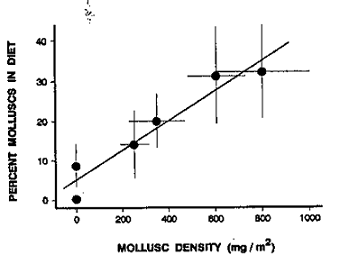Nutrition
The pumpkinseed sunfish is found to mainly feed on mollusks, and more specifically, snails. They consume these snails by crushing them with their jaws. Many studies have been carried out to research the effects on different changes or pressures present on populations of Pumpkinseed sunfish. The percentage of snails in an individual's diet is directly proportional to the snail abundance in its habitat. In other words, as the number of snails increase in the individual's habitat the percentage of nails consumed also increases (Mittelbach, Osenberg and Wainwright 1992).
There is also a positive correlation with the mass of the jaw
muscle, the levator posterior, and the percentage of snails in the
diet. The jaw muscles and the bones used to help the individual
crush its prey has been found to actually be smaller in those who
live in snail-poor habitats than those who are located in snail-rich
habitats. In fact, many times this main jaw muscle, the levator
posterior, is found to be twice as big in the fish located in areas
where there is a high abundance of snails than those who live in low
abundance habitats. Also, the teeth are usually worn down in the
fish that are in high abundance prey habitats due to the constant
crushing of snails. The individuals who live in bodies of water with
low snail abundance or are too small to consume snails tend feed
more on insect larvae and other soft bodied invertebrates. Other
observations show that the muscles and bones that are not used to
crush prey exhibit no difference between high or low prey abundance
populations (Mittelbach, Osenberg and Wainwright 1992).

